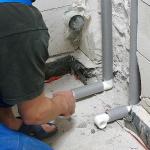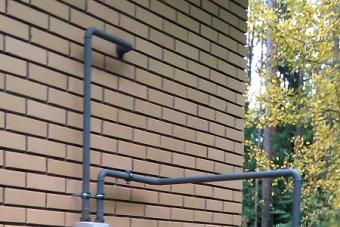Sometimes the abundance of pipes, risers, meters and other communications negates all the efforts and funds invested in repairs. They are like silent witnesses of your defeat, they seem to be useful, but treacherously “tell” the truth and cause unpleasant emotions. The richest rooms in terms of communication are the toilet and bathroom. Let's talk about how to hide the pipes in the toilet so that the guests admire, and the neighbors kindly envy your imagination.
Rules for hiding pipes
Usually, hidden piping in the bathroom or toilet is done in parallel with the construction of the house or the renovation of the premises. But there are times when ugliness is annoying, but there are no special funds for cardinal changes in the home. Then it is necessary, without restraining creative impulses, to come up with ways to disguise from the “cheap and cheerful” series, that is, to do a kind of decorating pipes in the toilet. But first things first.
Example: how to make a tiny bathroom both functional and beautiful
What to mask
What kind of pipes do we usually hide in the toilet? Of course, a lot depends on whether it is combined with a bathroom, what kind of plumbing is equipped, but in general it can be assumed that the following structures are present in the bathroom:
- pipe for connecting the toilet;
- fan outlet;
- wiring for sinks, bathrooms, bidets, and so on (both cold and hot water).
As a rule, the diameter of the elements for connecting the toilet is 110 mm, other plumbing points - 50 mm. The construction material is either plastic or cast iron. The latter is often present in Soviet-style houses and does not have good performance characteristics, moreover, it has too thick walls, which is why when masking such a network, centimeters of area that are important for tiny apartments are lost. But since you have chosen this option, you have to get out.

Closed way to mask the sewer
How to mask
So, how to hide the sewer pipe in the toilet? There are two main ways to install communications that are "an eyesore":
- Closed when the system becomes invisible due to strobe or installation of special structures. With a closed method, communications are completely hidden, the bathroom becomes more beautiful, but smaller.
- Open. Elements of the system are masked, but are in the public domain. This method is less aesthetic (although it all depends on imagination), but it saves space. In addition, the decor can be changed, thereby giving the bathroom a new style.

The frame must be strong, because you have to sheathe it with drywall, and then glue it with tiles, and that's all - weight
How to close up a sewer pipe in a toilet without compromising the performance of the system?
- Do not wall up the structure completely, there should be partial access to it to check the condition, and, possibly, repair;
- during the installation process, be careful not to damage the pipes, especially if you use plastic products;
- make a door or window better near the check valve, because it will have to be cleaned periodically;
- remember about the angle of inclination;
- before hiding pipes in the bathroom or toilet, check their tightness;
- do not forget about access to the meters, you will have the necessary data on a monthly basis - to pay receipts for services.

Drywall box - halfway to completion
Disguise options
Let's look at how and how to close the sewer pipes in the toilet.
shutters
One of the most effective and cheapest ways to hide pipes in a toilet is to cover them with roller shutters, roller shutters or blinds. For cramped and tiny bathrooms, this is generally salvation. Shutters do not eat up space, they look stylish, they can be changed and installed from floor to ceiling. Moreover, in a niche, along with pipes and counters, you are free to place shelves, cabinets where you can store a decent amount of jars, bath stocks and inventory.

And here is the implemented idea using roller shutters
Blinds or shutters are easy to assemble and lower, you can “play” with the shades of products, changing the interior. This option is also great for sealing sewer pipes in the toilet of a rented apartment, when you want it to be beautiful, but it makes no sense to invest in repairs. Installation of such a structure is extremely simple, you can even dismantle it before you move out to another apartment if you want.
Video: decorating a bathroom with blinds or blinds
locker
In fact, this option is somewhat similar to the previous way of closing the pipes in the toilet, with the only difference being that this design is more fundamental. You can buy a ready-made locker, meanwhile, due to the characteristics of the node and individual sizes, this is not possible for all apartment owners. Often, the owners make an individual order for the manufacture of such a design. But you can do everything yourself
So, how to hide the pipes in the toilet with your own hands using this method?
Start by making the frame - to do this, use metal dowels to attach wooden blocks to the side walls. Screw the hinges to the frame, hang the doors on them. It is better to buy moisture resistant material, but another tree will do. The main thing is to cover the doors with paint or varnish. Do not forget to attach handles, and choose places so that none of the household members get hurt when getting up from the toilet.

This is how the locker looks - beautiful and functional, right ?!
In the locker, you are free to store a bunch of themed useful tools and things. Using this method, the upper part of the pipes will close, while the lower part, near the toilet, can still be an eyesore. Then make or buy a screen, a panel or the same shutters. You probably don’t need to talk about how to close the pipes in the toilet with plastic panels or a sheet of chipboard / plasterboard.
Just purchase or cut a piece of the desired size and install it in a niche so that the top rests against the bottom of the cabinet. If you use chipboard / plasterboard, then the material also needs to be painted (you most likely will have paint left after painting the doors).
Another closed type method is the installation of a box. Its dimensions may vary: you can make a structure only at the bottom - near the toilet, or you can grab a fragment of the wall to the ceiling.
So, how to close the pipes in a drywall toilet with your own hands? First you need to make the body. Wooden bars or a metal profile are suitable for the base. Of the tools you will need a puncher, hammer, level, marker, tape measure. You also need to stock up on dowel-nails, self-tapping screws with a press washer (popularly referred to as "fleas") and glue.

See how many communications can be hidden in a box
The structure is covered with plasterboard or plastic. If you choose a drywall box, then it will need to be pasted over with tiles - the same as on the walls or contrasting. Do not forget about the window for checking the status and repairing the system. The box can also be multi-level - it all depends on your imagination and plans for arranging a bathroom.

Two-level drywall box covered with tiles
Gating
How to hide a sewer pipe in a toilet so as not to lose a millimeter of usable space? Use gating, which means making a series of recesses in those places on the wall where the network is planned to be laid. One of the best ways to mask pipes, but laborious and has a number of limitations.

Photofragment of the strobing process
Get to know them:
- the diameter of the pipes should not exceed 50 mm, which means that the plumbing to the toilet and the riser cannot be hidden in this way;
- the furrow should be less than 15% of the wall thickness;
- installation of inspection hatches is required.





